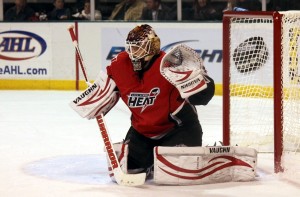The waiver wire is one of the most crucial aspects of player personnel management and the new NHL Collective Bargaining Agreement. Waivers are also one of the most misunderstood parts of hockey.

WHO GOES ON WAIVERS?
Waiver exemptions are spelled out in section 13.4 of the NHL’s CBA and depend on the age a player signs their entry-level contract and their NHL games-played. Once they meet one of the listed exemption requirements, they’re waiver eligible.
For skaters, players are exempt for:
- signed at 18: exempt for 5 years after signing or 160 NHL games
- signed at 19: exempt for 4 years or 160 NHL games
- signed at 20: exempt for 3 years or 160 NHL games
- signed at 21: exempt for 3 years or 80 NHL games
- signed at 22: exempt for 3 years or 70 NHL games
- signed at 23: exempt for 3 years or 60 NHL games
- signed at 24: exempt for 2 years or 60 NHL games
- signed at 25 or older: exempt for 1 year regardless of games played
For goaltenders, players are exempt for:
- signed at 18: exempt for 6 years after signing or 80 NHL games
- signed at 19: exempt for 5 years or 160 NHL games
- signed at 20: exempt for 4 years or 80 NHL games
- signed at 21: exempt for 4 years or 80 NHL games
- signed at 22: exempt for 4 years or 60 NHL games
- signed at 23: exempt for 3 years or 60 NHL games
- signed at 24: exempt for 2 years or 60 NHL games
- signed at 25 or older: exempt for 1 year regardless of games played
In practice, this usually means that almost all skaters are exempt for their entire entry-level contract and goaltenders are exempt for their entry-level contract and one additional season. There are some exceptions here and there, but that’s the general rule of thumb.
Example: Calgary goaltender Joni Ortio is waiver exempt for four years (or 80 NHL games) because he signed his first deal when he was 20. However, Reto Berra signed his first NHL deal when he was 26, he was only waiver exempt for his first season.
Injured players can also be sent down to the AHL on a conditioning loan for up to 14 days without requiring waivers, but they will count as part of their club’s 23-man NHL roster while on that loan.
WHEN DO WAIVERS HAPPEN?
The regular season waiver period begins 12 days prior to the beginning of the regular season and ends the day after a team’s last game. Players are on waivers for 24 hours and waiver wire priority is based on the club with the lowest points percentage at the time a player is placed on waivers; the worst teams get a chance to improve by getting first crack, and then the next-worst team, and so on. If no team claims a player during the waiver period, they’re said to have “cleared waivers.”
IF A PLAYER CLEARS:
If a player clears, he can be sent to the minors, kept on the NHL roster or traded to another team.
A player who clears waivers does not require waivers again until they’ve spent 30 cumulative days on an NHL roster or played in 10 NHL games since they last cleared waivers. They can be recalled to the NHL and reassigned an unlimited amount of times as long as they don’t meet those requirements. Even if they’ve started accruing NHL days or NHL games, clearing waivers “re-sets the clock” as far as their waiver eligibility goes.
IF A PLAYER IS CLAIMED:
If a player is claimed, they report to the team that claimed them. Or, if more than one team puts in a claim, they go to the claiming team with the highest waiver priority (or lowest points percentage).
If a team that claims a player on waivers wishes to trade them before the end of that season’s playoffs, they have to first offer that player to any other teams that claimed them under the same conditions (e.g., they pay the waiver fee).

If a team that claims a player on waivers wishes to put them in the minors can do so, as long as that player clears the waiver process. In other words, a team can’t claim a player on waivers and then send them to the AHL. However, if the claiming team originally had the player in the first place, that club can send them to the minors right away.
Example: If Calgary puts Mike Vernon on waivers and he’s claimed by Detroit, Detroit can’t put him in the AHL without another waiver process. But if Calgary claims Vernon off waivers after losing him earlier in the season, they can send him straight to the minors without another waiver process.
DOES IT MATTER IF A CONTRACT IS 1-WAY OR 2-WAY?
Nope. Players on one-way contracts get paid their NHL salary whether they’re in the NHL or the minors, while players on a two-way contract have a set NHL salary and a different set minor league salary. That’s the only difference. The type of contract a player is under has absolutely no bearing on their waiver status.
WHAT ARE UNCONDITIONAL WAIVERS?
Unconditional waivers are a special waiver process where a club offers a player to every other team prior to terminating a player’s contract. These are also called “$125 waivers,” after the different waiver fee paid. It is very rare that players are claimed off of unconditional waivers.
WHAT’S CHANGED SINCE THE LAST CBA?
Re-entry waivers have been eliminated.